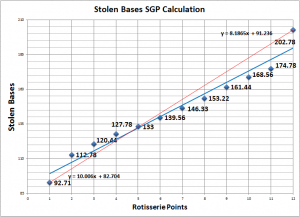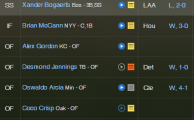Think of players like Ben Zobrist, Martin Prado, and Matt Carpenter.
In recent seasons, players like these have been eligible to play multiple positions. The big question is, “All else equal, should you pay more for a multi-eligible player than a player only eligible at one position?”.
I think there’s a clear answer to this question. And it might surprise you.
The Argument That They Are Not Worth More
Would you pay $2 more for Player A because he’s also second base eligible?
Player A (2B / SS): .272, 10 HR, 83 R, 52 RBI, 10 SB
Player B (SS): .275, 11 HR, 78 R, 55 RBI, 8 SB
Some very intelligent fantasy baseball minds will tell you that a player with multi-position eligibility is not worth more. For instance:
However, since playing more than one position doesn’t mean the player will produce any extra stats, he doesn’t have any greater an actual dollar value than someone who plays only one position.
~ Larry Schechter, Winning Fantasy Baseball
If you haven’t read Schechter’s book, you need to. It is loaded with very clear and well-reasoned thoughts and strategies like this one.
When you read the book, it becomes clear that Larry has a very bottom line approach. If a possible decision ends up adding dollar value to your team, you choose that option. If there is no measurable benefit in dollar value, you don’t.
I love the approach. That’s why I think everyone should create their own rankings. Attaching dollar values to players makes all decisions systematically easier to make. You no longer have to agonize over decisions like, “Should I drop player X and add player Y from the waiver wire?”. It’s a lot easier to simply look at each player’s projected dollar value for the rest of the season and decide.
With that said, I think it’s a little short-sighted to only look at the dollar value of a player at a given point in time.
Let’s Play Cards
My wife says my analogies are horrible, but I’m going to try a few on you anyways. Before we get into specific scenarios involving fantasy baseball, let’s first consider a couple of card game examples.
Blackjack
We can probably agree that the ace is the most powerful card in blackjack. A big reason for this is that it’s a gateway to reaching the total of 21. Without an ace you need a combination of two cards to get to 11 or 21 (2 & 9, 3 & 8, etc.). But the ace gets you there in one card.
Another huge power of the ace is its ability to act as two different cards, a 1 or an 11. It’s an insurance policy. You can behave as if it’s an 11 and quickly change it to a 1 if you bust. It lets you take risks you wouldn’t otherwise take. Keep this in mind.
I’ll end the blackjack example with a question. Assume an 8 in blackjack could be used as an 8 or a 3. You get to decide. Would that make the card more valuable to you than a card that could only be used as an 8?
Poker
I’m not a poker guru but I played my share of Texas Hold’em games in the early 2000’s just like everyone else.
In my mind, a huge decision-making factor in poker is the number of helpful cards (or “outs”) left in the deck.
For example, if you have a pair of 9s, we know there are only two helpful cards remaining (the other two 9s) to help you make three of a kind.
Or maybe you have an open-ended straight like a 4, 5, 6, and 7. In this case there are four 3s and four 8s that would finish of your straight, for a total of eight “outs”.
| Your Hand |
Your Goal |
Outs |
| One Pair |
Three of a Kind |
2 |
| Two Pair |
Full House |
4 |
| Inside Straight |
Straight |
4 |
| Open-ended Straight |
Straight |
8 |
| Four Flush Cards |
Flush |
9 |
| Straight / Flush Draw |
Straight / Flush |
15 |
(more…)








